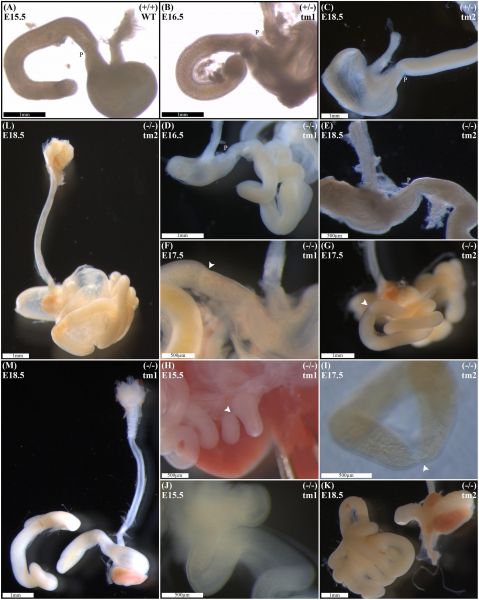File:Duodenal atresia 03.jpg

Original file (2,361 × 2,955 pixels, file size: 425 KB, MIME type: image/jpeg)
Duodenal Atresia - Mouse Model FGF10 KO
Duodenal phenotype characterization. Normal gastric, pyloric, and duodenal morphology was demonstrated by wild type embryos (A), as well as Fgf10 heterozygous embryos for tm1 (B), and tm2 (C) strains. Null Fgf10 embryos universally demonstrated microgastria, but duodenal morphology varied according to presence and type of DA. Null embryos provided examples of: normal continuity and morphology of the duodenum for tm1 (D) and tm2 (E); type 1 DA, tm1 (F) and tm2 (G); type 2 DA, tm1 (H) and tm2 (I); and type 3 DA, tm1 (J) and tm2 (K). (L) Type 2 DA demonstrating a “double bubble” with significantly dilated proximal duodenum; tm2. (M) Type 3 DA demonstrating an intact esophagus, in the presence of tracheal atresia; tm1. Annotations denote genotype, scale bars, and location of pylorus, P. Arrows indicate location atresia in type 1 DA and type 2 DA examples. Gestational ages for each panel are as stated.
| ICD-11 LB14 Structural developmental anomalies of duodenum - Any congenital defect of duodenum that results from interference with the normal growth and differentiation of the fetus. Such defects can arise at any stage of embryonic development, vary greatly in type and severity, and are caused by a wide variety of determining factors, including genetic mutations, chromosomal aberrations, teratogenic agents, and environmental factors. Most developmental defects are apparent at birth, especially any structural malformation, but some becomes evident later. |
- Links: duodenal atresia | FGF | mouse | gastrointestinal abnormalities | image 1 | image 2
Reference
Teague WJ, Jones MLM, Hawkey L, Smyth IM, Catubig A, King SK, Sarila G, Li R & Hutson JM. (2018). FGF10 and the Mystery of Duodenal Atresia in Humans. Front Genet , 9, 530. PMID: 30473704 DOI.
Copyright
© 2018 Teague, Jones, Hawkey, Smyth, Catubig, King, Sarila, Li and Hutson. This is an open-access article distributed under the terms of the Creative Commons Attribution License (CC BY). The use, distribution or reproduction in other forums is permitted, provided the original author(s) and the copyright owner(s) are credited and that the original publication in this journal is cited, in accordance with accepted academic practice. No use, distribution or reproduction is permitted which does not comply with these terms.
Fgene-09-00530-g002.jpg
Cite this page: Hill, M.A. (2024, April 27) Embryology Duodenal atresia 03.jpg. Retrieved from https://embryology.med.unsw.edu.au/embryology/index.php/File:Duodenal_atresia_03.jpg
- © Dr Mark Hill 2024, UNSW Embryology ISBN: 978 0 7334 2609 4 - UNSW CRICOS Provider Code No. 00098G
File history
Click on a date/time to view the file as it appeared at that time.
| Date/Time | Thumbnail | Dimensions | User | Comment | |
|---|---|---|---|---|---|
| current | 16:32, 16 April 2019 |  | 2,361 × 2,955 (425 KB) | Z8600021 (talk | contribs) | ==Duodenal atresia - Mouse Model FGF10 KO== 30473704 Copyright © 2018 Teague, Jones, Hawkey, Smyth, Catubig, King, Sarila, Li and Hutson. This is an open-access article distributed under the terms of the Creative Commons Attribution License (CC BY)... |
You cannot overwrite this file.
File usage
The following 2 pages use this file: